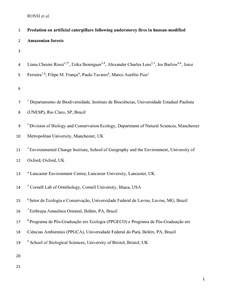Rossi, LC, Berenguer, E, Lees, AC  ORCID: https://orcid.org/0000-0001-7603-9081, Barlow, J, Ferreira, J, França, FM, Tavares, P and Pizo, MA
(2022)
Predation on artificial caterpillars following understorey fires in human-modified Amazonian forests.
Biotropica, 54 (3).
pp. 754-763.
ISSN 0006-3606
ORCID: https://orcid.org/0000-0001-7603-9081, Barlow, J, Ferreira, J, França, FM, Tavares, P and Pizo, MA
(2022)
Predation on artificial caterpillars following understorey fires in human-modified Amazonian forests.
Biotropica, 54 (3).
pp. 754-763.
ISSN 0006-3606
Abstract
Tropical forests are facing several impacts from anthropogenic disturbances, climate change, and extreme climate events, with potentially severe consequences for ecological functions, such as predation on folivorous invertebrates. Folivory has a major influence on tropical forests by affecting plant fitness and overall seedling performance. However, we do not know whether the predation of folivorous arthropods by birds, mammals, reptiles, and other arthropods is affected by anthropogenic disturbances such as selective logging and forest fires. We investigated the impacts of both pre-El Niño human disturbances and the 2015–2016 El Niño understorey fires on the predation of 4500 artificial caterpillars across 30 Amazonian forest plots. Plots were distributed in four pre-El Niño forest classes: undisturbed, logged, logged-and-burned, and secondary forests, of which 14 burned in 2015–16. We found a higher predation incidence in forests that burned during the El Niño in comparison with unburned ones. Moreover, logged-and-burned forests that burned again in 2015–16 were found to have significantly higher predation incidence by vertebrates than other forest classes. However, overall predation incidence in pre-El Niño forest disturbance classes was similar to undisturbed forests. Arthropods were the dominant predators of artificial caterpillars, accounting for 91.5% of total predation attempts. Our results highlight the resilience of predation incidence in human-modified forests, although the mechanisms underpinning this resilience remain unclear. Abstract in Portuguese is available with online material.
| Item Type: |
Article
|
| Peer-reviewed: |
Yes
|
| Date Deposited: |
19 Apr 2022 08:36
|
| Publisher: |
Wiley |
| Additional Information: |
This is the peer reviewed version of the following article: Rossi, L. C., Berenguer, E., Lees, A. C., Barlow, J., Ferreira, J., França, F. M., Tavares, P., & Pizo, M. A. (2022). Predation on artificial caterpillars following understorey fires in human-modified Amazonian forests. Biotropica, which has been published in final form at https://doi.org/10.1111/btp.13097. This article may be used for non-commercial purposes in accordance with Wiley Terms and Conditions for Use of Self-Archived Versions. This article may not be enhanced, enriched or otherwise transformed into a derivative work, without express permission from Wiley or by statutory rights under applicable legislation. Copyright notices must not be removed, obscured or modified. The article must be linked to Wiley’s version of record on Wiley Online Library and any embedding, framing or otherwise making available the article or pages thereof by third parties from platforms, services and websites other than Wiley Online Library must be prohibited. |
| Divisions: |
Faculties > Science and Engineering |
| Subject terms: |
Science & Technology, Life Sciences & Biomedicine, Ecology, Environmental Sciences & Ecology, Amazon, arthropods, dummy caterpillar, El Nino, forest degradation, forest fires, forest regeneration, herbivory control, RAIN-FOREST, HERBIVOROUS INSECTS, RECURRENT WILDFIRES, LEAF DAMAGE, BIRDS, RESPONSES, BIODIVERSITY, FRAGMENTATION, DEFORESTATION, ARTHROPODS, 05 Environmental Sciences, 06 Biological Sciences, 07 Agricultural and Veterinary Sciences, Ecology |
| URI: |
https://e-space.mmu.ac.uk/id/eprint/629523 |
| DOI: |
https://doi.org/10.1111/btp.13097 |
| ISSN |
0006-3606 |
| e-ISSN |
1744-7429 |
Impact and Reach
Statistics
Additional statistics for this dataset are available via
IRStats2.
Altmetric
Repository staff only
 |
Edit record |

![[img]](https://e-space.mmu.ac.uk/629523/3.hassmallThumbnailVersion/Rossi_et_al_Predation%20on%20artificial%20caterpillars%20following%20understorey%20fires%20in%20human-modified%20Amazonian%20forests.pdf)



